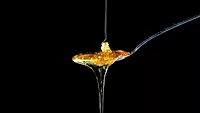FDA Food Fraud Testing Finds Adulteration Among 10 Percent of Honey Imports

Credit: Roman Odintsov (roman-odintsov) via Pexels
A sampling and testing assignment conducted by the U.S. Food and Drug Administration (FDA) found 10 percent of imported honey samples to be adulterated.
FDA collected and tested honey imported to the U.S. in 2021 and 2022 for economically motivated adulteration (EMA), which is also known as “food fraud” when relevant to food products. FDA defines EMA in relation to food as “intentionally leaving out, taking out, or substituting a valuable ingredient or part of a food… or adding a substance to a food to make it appear better or of greater value.”
The specific aim of the FDA sampling and testing assignment was to identify products that contained undeclared added sweeteners (when the product is labeled solely as “honey” rather than a “blend”) and prevent them from being distributed in the U.S. market. Some honey producers engage in food fraud to lower production costs by adding undeclared, inexpensive sweeteners to the product, such as syrups derived from cane, corn, rice, or sugar beets.
FDA cites studies suggesting that EMA of honey is somewhat prevalent, with a rate of 13 percent in Canada and 14 percent in the EU in recent years. Additionally, more than 70 percent of the honey consumed in the U.S. is imported. Therefore, FDA conducted the present assignment to better understand the extent of EMA among imported honey, and to identify fraudulent products and prevent them from being distributed in the U.S. market.
From January 2021–March 2022, FDA collected and tested 144 samples of imported honey to test for undeclared added sweeteners. Each sample was made up of three subsamples, with each subsample containing at least 240 milliliters (mL) of honey. FDA field personnel collected all the samples from either bulk or retail packaged shipments labeled as “honey.” Retail packaged samples consisted of individual jars or other containers intended for sale. Bulk shipment samples were collected typically from barrels or drums, with the use of sterile equipment and aseptic procedures.
The honey evaluated for the assignment was imported from 32 countries. About 40 percent of the samples originated in India and Vietnam, which have been the top two sources of honey imported by the U.S. in four of the last five years. FDA collected all the samples in import status, which refers to products collected at ports of entry or other locations where they are held prior to being released into the U.S. market.
The agency used Stable Carbon Isotope Ratio Analysis (SCIRA) to analyze the organic composition of each honey and determine whether the honey was in compliance with FDA regulations. When the agency found a subsample to have carbon isotope values atypical to those of authentic honey, the agency classified the associated sample as noncompliant.
Looking for quick answers on food safety topics?
Try Ask FSM, our new smart AI search tool.
Ask FSM →
Of the 144 import samples collected and tested, FDA found 14 (10 percent) to be noncompliant. The remainder of samples were in compliance. Of the 144 import samples, 75 were collected from bulk shipments and 69 were collected from retail shipments. The difference in the adulteration rate of the bulk shipment samples versus the retail shipment samples was undetectable based on the available data.
The agency cautions against making inferences or comparisons based on the data on nations of origin for noncompliant honey, due to the small sample sizes and the fact that FDA did not design the assignment for such purposes. However, the majority of adulterated honey was imported from Yemen (4 of 4 samples), followed by Vietnam (3 of 28 samples), the Dominican Republic (2 of 2 samples), Thailand (1 of 1 samples), Lebanon (1 of 1 samples), Greece (1 of 4 samples), Italy (1 of 4 samples), and India (1 of 29 samples).
Based on its testing results, FDA refused entry of noncompliant shipments into the U.S. and placed the associated company and product on Import Alert (IA) 36-01. Products listed on the IA are subject to Detention without Physical Examination. For those products to be admitted into the U.S., the company is required to provide evidence to FDA to overcome the appearance of a violation, such as the test results of a third-party laboratory, verifying that the product does not contain added sweeteners.
FDA states that the results of the assignment reaffirm the need for the agency to continue to test imported honey for EMA under the agency’s risk-based import entry screening program. FDA will also continue to collaborate with international counterparts to detect and combat EMA related to imported products, including imported honey.








